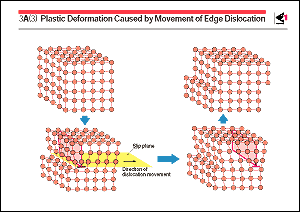A material is worked by utilizing
plastic deformation to give it a shape suitable for its application.
In this process, a change occurs not only in the visible shape
and size, but also at the atomic level in the interior of the
material.
Plastic deformation of a metal occurs by slipping of atoms on
specific planes of a crystal. This slipping of atoms does not
occur at any one time over the entire crystal plane. In fact,
it occurs by the movement of linear lattice defects called dislocations.
The figure shows the atomic structure of an edge dislocation
and the process by which plastic deformation occurs when the
dislocation moves on the slip plane.
Materials in which dislocations can move easily are those which
tend to be soft and subject to easy plastic deformation. On the
other hand, hard and strong materials can be obtained if it is
difficult for dislocations to move. Factors that make it difficult
for dislocations to move include foreign atoms in solid solutions
and precipitated particles. Hardening by these factors is referred
to as solid solution hardening and precipitation hardening, respectively.
As plastic deformation proceeds, many dislocations accumulate
in a crystal, which interact with each other and prevent movement
of the dislocation. Therefore, a material becomes harder as
plastic deformation continues. This is called work hardening.
A work hardened material returns to its former soft state when
the accumulated dislocations disappear. When the work-hardened
material is heated in an annealing process, a large number of
dislocations disappear through the diffusion of atoms. During
hot rolling, the as-rolled material is soft because both work
hardening and annealing occur simultaneously. However, during
cold rolling, only a work hardening occurs and, therefore, cold-rolled
material is hard and brittle.
Another change in the crystal as a result of plastic deformation
is the rotation of a crystal, which occurs when plastic deformation
is caused only on a specific plane and direction of slipping.
The rotation of a crystal forms a texture in which the crystal
grains are oriented in the direction of the mechanical working.
In cold rolling with a large amount of deformation, the crystal
grains become elongated. If a material with elongated grains
is heated after being subjected to plastic deformation above
the critical value, new equiaxed grains with fewer dislocations
nucleate and grow, and the material returns to the soft state
that existed before deformation. This phenomenon, which is called
recrystallization, is used for the refining and softening of
crystal grains. |
|
 |
 |
 |
|
|